"Talung" 1989
"Taja" 1988
APICHAI PIROMRAK |
| Creative Idea of his Art Work |
| Apichai
Piromrak forms his work into contemporary art that conveys Thai style and Buddhist
Teachings. He uses the philosophy, the symbolism, and the way of Buddhist teaching to
express his ideas and feelings about the faith. His expression takes the form of
contemporary Thai Art. During his study at the Faculty of Painting Sculpture and Graphic Arts, Silpakorn University, Apichai first took Lithography. After working on the mural painting at Buddhapradipa Temple, London, he continued in his 3rd year, studying Thai Art. During that time he began to use traditional techniques to create his series, “ Talung”, but using his own new forms. |
|
"Talung" 1989 |
"Taja" 1988 |
| During his work at Buddhapradipa Temple, London, he had a dream that inspired his thesis, in which the forms and movements of traditional Thai art are mixed with his own self expression. |
|
"Khiriyamek (Three-Headed Elephant)" 1989 |
"The Defeat of Mara" 1990 |
| After he finished his bachelor’s degree, his work began to emphasize abstraction rather than technique, but retained the frame work of Buddhist themes and philosophy. |
| I n his thesis, Apichai worked with the signs and symbols of Buddhism. The work became more still, more peaceful. There was only some little movement of lines and forms in his thesis works. |
|
"Sema" 1991 |
"Figure 5" 1991 |
| When he was given a scholarship to study Lithography in Germany, he created forty Lithographs. He used traditional techniques with simply developed recurring forms of triangles, rectangles and circles. These represented the state of his mind at that time, which was restless, depressed and frustrated |
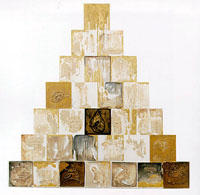 |
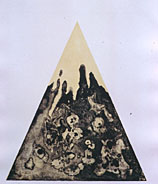 |
| His present creative works still show their simple forms, using symbols such as triangles, rectangles and circles to represent new meanings of his abstracted feelings and Buddhist philosophy. |
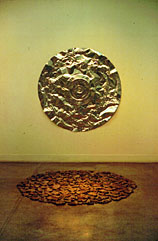 "eras" 1997 |
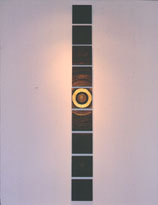 "The Wheel of Life" 1993 |
|
"The Wheel of Life" 1993 |
| In 1997, Apichai chose “ The Wheel of Life” as the theme for his work, using the symbol of one hundred and eight squares of Good-luck from traditional Thai art to convey his expression of self-transformation. Sometimes he used “The Cycle of Life” i.e. birth-death, birth-death… as the theme of his expression, creating works which have a soul of Buddhist philosophy but which, in their expression, emphasize the feelings of the artist at the time. |
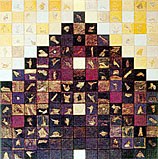 |
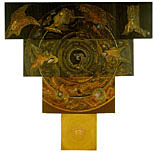 "The End of Cycle 1997" 1998 |
| As an instructor at the Faculty of Painting Sculpture and Graphic Arts, accompanying his students to see mural paintings in various places, Apichai gained an appreciated the free forms of these paintings and wanted to conserve them. He, therefore, commenced his art work by copying the mural paintings on stiff paper, selecting images in various parts of the painting, and greatly enlarging them until it seemed as though the paper itself were a fallen piece of the mural painting. This was a way to show his love and appreciation for the paintings. |
| THE CREATIVE TREND OF HIS ART WORK IN THE FUTURE |
| At first Apichai’s works emphasized various techniques and procedures. But after he finished his study in lithography in Germany in 1995. He returned to his starting point once more, working on his paintings with great skill. With his interest in mural painting, he progressed by adding colours and more texture to his enlarged works, form the small broken pieces of mural paintings. Sometimes the size of his art work was a hundreds times the size of the actual pieces that he had copied. At a closer look, his painting appears as an abstract form of a traditional colorful painting, but from a distance of two or three meters, the painting appears to be a sign or symbol, such as, an image of Buddha, or a lotus-shaped pedestal. It appears that his working theme is changing and he will need more 2-3 years to fulfill the cycle of his evolution and finishes his art work for exhibition. |
| One of his works was in the form of a three dimensional creation or “installation” entitled “The Spiritual Trees” which was one of the entries of the “Bangkok Art Project 1998”. In that work, he chose a two hundred-year-old trunk which stands before the royal cemetary of Raja Bopitr Temple. This was his medium of expression. He covered the trunk of the old tree with cloth and leaned a ladder against it, successfully conveying his meaning. |
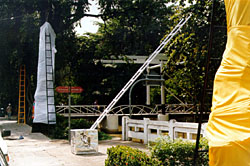 |
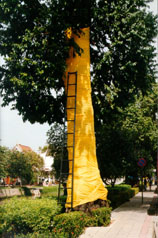 |
"The Spiritual Trees" 1998 |
|